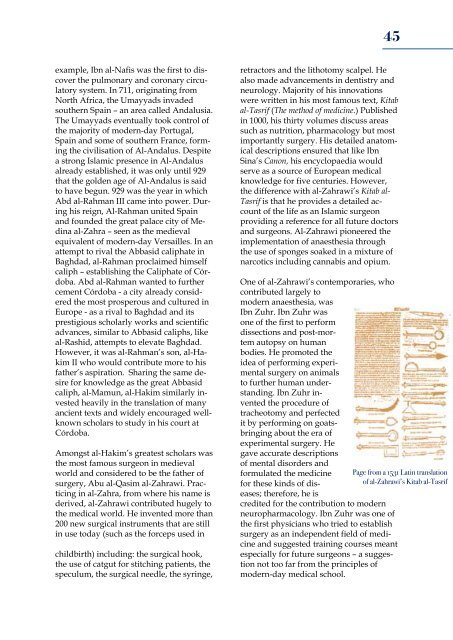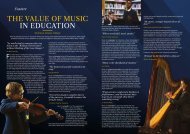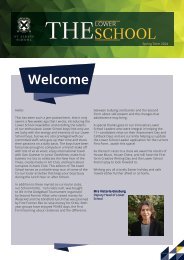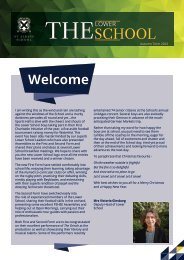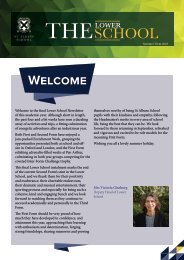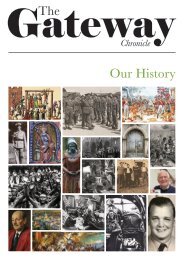You also want an ePaper? Increase the reach of your titles
YUMPU automatically turns print PDFs into web optimized ePapers that Google loves.
45<br />
example, Ibn al-Nafis was the first to discover<br />
the pulmonary and coronary circulatory<br />
system. In 711, originating from<br />
North Africa, the Umayyads invaded<br />
southern Spain – an area called Andalusia.<br />
<strong>The</strong> Umayyads eventually took control of<br />
the majority of modern-day Portugal,<br />
Spain and some of southern France, forming<br />
the civilisation of Al-Andalus. Despite<br />
a strong Islamic presence in Al-Andalus<br />
already established, it was only until 929<br />
that the golden age of Al-Andalus is said<br />
to have begun. 929 was the year in which<br />
Abd al-Rahman III came into power. During<br />
his reign, Al-Rahman united Spain<br />
and founded the great palace city of Medina<br />
al-Zahra – seen as the medieval<br />
equivalent of modern-day Versailles. In an<br />
attempt to rival the Abbasid caliphate in<br />
Baghdad, al-Rahman proclaimed himself<br />
caliph – establishing the Caliphate of Córdoba.<br />
Abd al-Rahman wanted to further<br />
cement Córdoba - a city already considered<br />
the most prosperous and cultured in<br />
Europe - as a rival to Baghdad and its<br />
prestigious scholarly works and scientific<br />
advances, similar to Abbasid caliphs, like<br />
al-Rashid, attempts to elevate Baghdad.<br />
However, it was al-Rahman’s son, al-Hakim<br />
II who would contribute more to his<br />
father’s aspiration. Sharing the same desire<br />
for knowledge as the great Abbasid<br />
caliph, al-Mamun, al-Hakim similarly invested<br />
heavily in the translation of many<br />
ancient texts and widely encouraged wellknown<br />
scholars to study in his court at<br />
Córdoba.<br />
Amongst al-Hakim’s greatest scholars was<br />
the most famous surgeon in medieval<br />
world and considered to be the father of<br />
surgery, Abu al-Qasim al-Zahrawi. Practicing<br />
in al-Zahra, from where his name is<br />
derived, al-Zahrawi contributed hugely to<br />
the medical world. He invented more than<br />
200 new surgical instruments that are still<br />
in use today (such as the forceps used in<br />
childbirth) including: the surgical hook,<br />
the use of catgut for stitching patients, the<br />
speculum, the surgical needle, the syringe,<br />
retractors and the lithotomy scalpel. He<br />
also made advancements in dentistry and<br />
neurology. Majority of his innovations<br />
were written in his most famous text, Kitab<br />
al-Tasrif (<strong>The</strong> method of medicine.) Published<br />
in 1000, his thirty volumes discuss areas<br />
such as nutrition, pharmacology but most<br />
importantly surgery. His detailed anatomical<br />
descriptions ensured that like Ibn<br />
Sina’s Canon, his encyclopaedia would<br />
serve as a source of European medical<br />
knowledge for five centuries. However,<br />
the difference with al-Zahrawi’s Kitab al-<br />
Tasrif is that he provides a detailed account<br />
of the life as an Islamic surgeon<br />
providing a reference for all future doctors<br />
and surgeons. Al-Zahrawi pioneered the<br />
implementation of anaesthesia through<br />
the use of sponges soaked in a mixture of<br />
narcotics including cannabis and opium.<br />
One of al-Zahrawi’s contemporaries, who<br />
contributed largely to<br />
modern anaesthesia, was<br />
Ibn Zuhr. Ibn Zuhr was<br />
one of the first to perform<br />
dissections and post-mortem<br />
autopsy on human<br />
bodies. He promoted the<br />
idea of performing experimental<br />
surgery on animals<br />
to further human understanding.<br />
Ibn Zuhr invented<br />
the procedure of<br />
tracheotomy and perfected<br />
it by performing on goatsbringing<br />
about the era of<br />
experimental surgery. He<br />
gave accurate descriptions<br />
of mental disorders and<br />
formulated the medicine Page from a 1531 Latin translation<br />
for these kinds of diseases;<br />
therefore, he is<br />
of al-Zahrawi’s Kitab al-Tasrif<br />
credited for the contribution to modern<br />
neuropharmacology. Ibn Zuhr was one of<br />
the first physicians who tried to establish<br />
surgery as an independent field of medicine<br />
and suggested training courses meant<br />
especially for future surgeons – a suggestion<br />
not too far from the principles of<br />
modern-day medical school.


